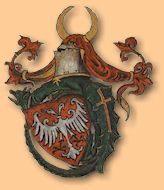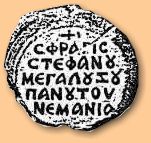The Lazarevics
Serbian: Lazarevic
Laza:revitch/
 |
COAT OF ARMS DETAILS |
Lazar Hrebljanovic (his family was called Lazarevic after him) was the most important nobleman after the Nemanjics disappeared from the political scene. Although he actually never ruled entire Serbia which was divided between several families, Lazar was the most influential and the strongest.
Economically and administratively, Lazar did the best to prepare the realm for the impending showdown with the advancing Ottoman tide. His early control of the important mines and mints at Rudnik and Novo Brdo enabled prosperity, and the influx of refugees - including highly skilled ones -from the Turkish-occupied lands facilitated an intellectual boost. Numerous monasteries, many of a characteristic and original style, were erected, the preeminent among them being the prince's key endowment, Ravanica.

Gold Seal of Prince Lazar
It was he who led the Serbian army on June 28, 1389 when he was captured by the Turks and beheaded. His tragic faith created a myth among the people who named him "Emperor Lazar" although he never had such title. His wife Milica ruled the country after his death until his son, Stefan became new Prince of Serbia in 1402.
Stefan was obliged to participate in the Turkish campaigns, his sister Olivera was married to the Turkish sultan Bayazit, but Stefan was always trying to help his country maintain certain degree of independence.
According to his contemporaries, despot Stefan was a medieval warrior, a well educated knight, delicate poet and humanistic savant, all at the same time, owned a huge personal library and loved literature. He was a writer himself and wrote two poems Pillar Writing and "Word of Love".

Seal
of Prince Stefan
He also belonged to the highest class of Hungarian aristocracy and invested in huge possessions in Hungary where he settled Serbs. Stefan didn't have his own sons so he left the title and named his cousin Djuradj Brankovic as his successor; soon after, he died in 1427.